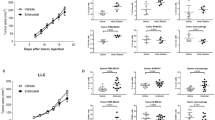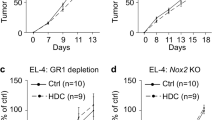Abstract
Myeloid-derived suppressor cells (MDSC) have been identified as a population of immature myeloid cells that suppress anti-tumor immunity. MDSC are increased in tumor-bearing hosts; thus, depletion of MDSC may enhance anti-tumor immunity. Histone deacetylase inhibitors (HDACi) are chemical agents that are primarily used against hematologic malignancies. The ability of these agents to modulate anticancer immunity has recently been extensively studied. However, the effect of HDACi on MDSC has remained largely unexplored. In the present study, we provide the first demonstration that HDACi treatment decreases MDSC accumulation in the spleen, blood and tumor bed but increases the proportion of T cells (particularly the frequency of IFN-γ- or perforin-producing CD8+ T cells) in BALB/C mice with 4T1 mammary tumors. In addition, HDACi exposure of bone marrow (BM) cells significantly eliminated the MDSC population induced by GM-CSF or the tumor burden in vitro, which was further demonstrated as functionally important to relieve the inhibitory effect of MDSC-enriched BM cells on T cell proliferation. Mechanistically, HDACi increased the apoptosis of Gr-1+ cells (almost MDSC) compared with that of Gr-1− cells, which was abrogated by the ROS scavenger N-acetylcysteine, suggesting that the HDACi-induced increase in MDSC apoptosis due to increased intracellular ROS might partially account for the observed depletion of MDSC. These findings suggest that the elimination of MDSC using an HDACi may contribute to the overall anti-tumor properties of these agents, highlighting a novel property of HDACi as potent MDSC-targeting agents, which may be used to enhance the efficacy of immunotherapeutic regimens.





Similar content being viewed by others
Abbreviations
- Arg-1:
-
Arginase-1
- BM:
-
Bone marrow
- CFSE:
-
Carboxyfluorescein diacetate succinimidyl ester
- CTL:
-
Cytotoxic T lymphocyte
- DCFH-DA:
-
2′,7′ Dichlorodihydrofluorescein diacetate
- GM-CSF:
-
Granulocyte-macrophage colony stimulating factor
- HDACi:
-
Histone deacetylase inhibitor(s)
- IDO:
-
Indoleamine 2,3-dioxygenase
- iNOS:
-
Inducible nitric oxide synthase
- iTreg:
-
Inducible regulatory T cell
- l-NMMA:
-
l-NG-monomethyl-arginine
- MDSC:
-
Myeloid-derived suppressor cell(s)
- NaB:
-
Sodium butyrate
- NAC:
-
N-Acetylcysteine
- nor-NOHA:
-
N ω-Hydroxy-nor-l-arginine
- PBMC:
-
Peripheral blood mononuclear cell(s)
- ROS:
-
Reactive oxygen species
- SAHA:
-
Suberoylanilide hydroxamic acid
- SPC:
-
Spleen cell(s)
- TCR:
-
T cell receptor
References
Gabrilovich DI, Nagaraj S (2009) Myeloid-derived suppressor cells as regulators of the immune system. Nat Rev Immunol 9(3):162–174. doi:10.1038/nri2506
Youn J-I, Nagaraj S, Collazo M, Gabrilovich DI (2008) Subsets of myeloid-derived suppressor cells in tumor-bearing mice. J Immunol 181(8):5791–5802. doi:10.4049/jimmunol.181.8.5791
Peranzoni E, Zilio S, Marigo I, Dolcetti L, Zanovello P, Mandruzzato S, Bronte V (2010) Myeloid-derived suppressor cell heterogeneity and subset definition. Curr Opin Immunol 22(2):238–244. doi:10.1016/j.coi.2010.01.021
Gabrilovich DI, Bronte V, Chen S-H, Colombo MP, Ochoa A, Ostrand-Rosenberg S, Schreiber H (2007) The terminology issue for myeloid-derived suppressor cells. Cancer Res 67(1):425. doi:10.1158/0008-5472.can-06-3037
Gallina G, Dolcetti L, Serafini P, Santo CD, Marigo I, Colombo MP, Basso G, Brombacher F, Borrello I, Zanovello P, Bicciato S, Bronte V (2006) Tumors induce a subset of inflammatory monocytes with immunosuppressive activity on CD8+ T cells. J Clin Invest 116(10):2777–2790. doi:10.1172/jci28828
Ochoa AC, Zea AH, Hernandez C, Rodriguez PC (2007) Arginase, prostaglandins, and myeloid-derived suppressor cells in renal cell carcinoma. Clin Cancer Res 13(2):721s–726s. doi:10.1158/1078-0432.ccr-06-2197
Serafini P, De Santo C, Marigo I, Cingarlini S, Dolcetti L, Gallina G, Zanovello P, Bronte V (2004) Derangement of immune responses by myeloid suppressor cells. Cancer Immunol Immunother 53(2):64–72. doi:10.1007/s00262-003-0443-2
Bronte V, Serafini P, Apolloni E, Zanovello P (2001) Tumor-induced immune dysfunctions caused by myeloid suppressor cells. J Immunother 24(6):431–446
Marigo I, Dolcetti L, Serafini P, Zanovello P, Bronte V (2008) Tumor-induced tolerance and immune suppression by myeloid derived suppressor cells. Immunol Rev 222(1):162–179. doi:10.1111/j.1600-065X.2008.00602.x
Serafini P, Meckel K, Kelso M, Noonan K, Califano J, Koch W, Dolcetti L, Bronte V, Borrello I (2006) Phosphodiesterase-5 inhibition augments endogenous antitumor immunity by reducing myeloid-derived suppressor cell function. J Exp Med 203(12):2691–2702. doi:10.1084/jem.20061104
Kodumudi KN, Woan K, Gilvary DL, Sahakian E, Wei S, Djeu JY (2010) A novel chemoimmunomodulating property of docetaxel: suppression of myeloid-derived suppressor cells in tumor bearers. Clin Cancer Res 16(18):4583–4594. doi:10.1158/1078-0432.ccr-10-0733
Alizadeh D, Trad M, Hanke NT, Larmonier CB, Janikashvili N, Bonnotte B, Katsanis E, Larmonier N (2014) Doxorubicin eliminates myeloid-derived suppressor cells and enhances the efficacy of adoptive T-cell transfer in breast cancer. Cancer Res 74(1):104–118. doi:10.1158/0008-5472.can-13-1545
Suzuki E, Kapoor V, Jassar AS, Kaiser LR, Albelda SM (2005) Gemcitabine selectively eliminates splenic Gr-1+/CD11b+ myeloid suppressor cells in tumor-bearing animals and enhances antitumor immune activity. Clin Cancer Res 11(18):6713–6721. doi:10.1158/1078-0432.ccr-05-0883
Vincent J, Mignot G, Chalmin F, Ladoire S, Bruchard M, Chevriaux A, Martin F, Apetoh L, Rébé C, Ghiringhelli F (2010) 5-Fluorouracil selectively kills tumor-associated myeloid-derived suppressor cells resulting in enhanced T cell-dependent antitumor immunity. Cancer Res 70(8):3052–3061. doi:10.1158/0008-5472.can-09-3690
Khan AN, Gregorie C, Tomasi T (2008) Histone deacetylase inhibitors induce TAP, LMP, Tapasin genes and MHC class I antigen presentation by melanoma cells. Cancer Immunol Immunother 57(5):647–654. doi:10.1007/s00262-007-0402-4
Marks PA, Richon VM, Breslow R, Rifkind RA (2001) Histone deacetylase inhibitors as new cancer drugs. Curr Opin Oncol 13(6):477–483
Bolden JE, Peart MJ, Johnstone RW (2006) Anticancer activities of histone deacetylase inhibitors. Nat Rev Drug Discov 5(9):769–784
Maeda T, Towatari M, Kosugi H, Saito H (2000) Up-regulation of costimulatory/adhesion molecules by histone deacetylase inhibitors in acute myeloid leukemia cells. Blood 96(12):3847–3856
Magner WJ, Kazim AL, Stewart C, Romano MA, Catalano G, Grande C, Keiser N, Santaniello F, Tomasi TB (2000) Activation of MHC class I, II, and CD40 gene expression by histone deacetylase inhibitors. J Immunol 165(12):7017–7024. doi:10.4049/jimmunol.165.12.7017
Lee SY, Huang Z, Kang TH, Soong R-S, Knoff J, Axenfeld E, Wang C, Alvarez RD, Chen C-S, Hung C-F, Wu TC (2013) Histone deacetylase inhibitor AR-42 enhances E7-specific CD8+ T cell-mediated antitumor immunity induced by therapeutic HPV DNA vaccination. J Mol Med 91(10):1221–1231. doi:10.1007/s00109-013-1054-9
Bayne LJ, Beatty GL, Jhala N, Clark CE, Rhim AD, Stanger BZ, Vonderheide RH (2012) Tumor-derived granulocyte-macrophage colony-stimulating factor regulates myeloid inflammation and T cell immunity in pancreatic cancer. Cancer Cell 21(6):822–835. doi:10.1016/j.ccr.2012.04.025
Otaegui D, Rodríguez-Gascón A, Zubia A, Cossío FP, Pedraz JL (2009) Pharmacokinetics and tissue distribution of Kendine 91, a novel histone deacetylase inhibitor, in mice. Cancer Chemother Pharmacol 64(1):153–159. doi:10.1007/s00280-008-0857-9
Egorin JM, Yuan Z-M, Sentz LD, Plaisance K, Eiseman LJ (1999) Plasma pharmacokinetics of butyrate after intravenous administration of sodium butyrate or oral administration of tributyrin or sodium butyrate to mice and rats. Cancer Chemother Pharmacol 43(6):445–453. doi:10.1007/s002800050922
Jiang G-M, He Y-W, Fang R, Zhang G, Zeng J, Yi Y-M, Zhang S, Bu X-Z, Cai S-H, Du J (2010) Sodium butyrate down-regulation of indoleamine 2,3-dioxygenase at the transcriptional and post-transcriptional levels. Int J Biochem Cell Biol 42(11):1840–1846. doi:10.1016/j.biocel.2010.07.020
Jiang G-M, Wang H-S, Zhang F, Zhang K-S, Liu Z-C, Fang R, Wang H, Cai S-H, Du J (2013) Histone deacetylase inhibitor induction of epithelial–mesenchymal transitions via up-regulation of Snail facilitates cancer progression. Biochim Biophys Acta 1833(3):663–671. doi:10.1016/j.bbamcr.2012.12.002
Dokmanovic M, Marks PA (2005) Prospects: histone deacetylase inhibitors. J Cell Biochem 96(2):293–304. doi:10.1002/jcb.20532
Rosato R, Almenara J, Grant S (2003) The histone deacetylase inhibitor MS-275 promotes differentiation or apoptosis in human leukemia cells through a process regulated by generation of reactive oxygen species and induction of p21CIP1/WAF1 1. Cancer Res 63(13):3637–3645
Mundy-Bosse BL, Lesinski GB, Jaime-Ramirez AC, Benninger K, Khan M, Kuppusamy P, Guenterberg K, Kondadasula SV, Chaudhury AR, La Perle KM, Kreiner M, Young G, Guttridge DC, Carson WE (2011) Myeloid-derived suppressor cell inhibition of the IFN response in tumor-bearing mice. Cancer Res 71(15):5101–5110. doi:10.1158/0008-5472.can-10-2670
Ma C, Kapanadze T, Gamrekelashvili J, Manns MP, Korangy F, Greten TF (2012) Anti-Gr-1 antibody depletion fails to eliminate hepatic myeloid-derived suppressor cells in tumor-bearing mice. J Leukoc Biol 92(6):1199–1206. doi:10.1189/jlb.0212059
Kusmartsev S, Cheng F, Yu B, Nefedova Y, Sotomayor E, Lush R, Gabrilovich D (2003) All-trans-retinoic acid eliminates immature myeloid cells from tumor-bearing mice and improves the effect of vaccination. Cancer Res 63(15):4441–4449
van der Most R, Currie A, Mahendran S, Prosser A, Darabi A, Robinson BS, Nowak A, Lake R (2009) Tumor eradication after cyclophosphamide depends on concurrent depletion of regulatory T cells: a role for cycling TNFR2-expressing effector-suppressor T cells in limiting effective chemotherapy. Cancer Immunol Immunother 58(8):1219–1228. doi:10.1007/s00262-008-0628-9
Rosborough BR, Castellaneta A, Natarajan S, Thomson AW, Turnquist HR (2012) Histone deacetylase inhibition facilitates GM-CSF-mediated expansion of myeloid-derived suppressor cells in vitro and in vivo. J Leukoc Biol 91(5):701–709. doi:10.1189/jlb.0311119
Ostrand-Rosenberg S (2010) Myeloid-derived suppressor cells: more mechanisms for inhibiting antitumor immunity. Cancer Immunol Immunother 59(10):1593–1600. doi:10.1007/s00262-010-0855-8
Apetoh L, Ghiringhelli F, Tesniere A, Obeid M, Ortiz C, Criollo A, Mignot G, Maiuri MC, Ullrich E, Saulnier P, Yang H, Amigorena S, Ryffel B, Barrat FJ, Saftig P, Levi F, Lidereau R, Nogues C, Mira J-P, Chompret A, Joulin V, Clavel-Chapelon F, Bourhis J, Andre F, Delaloge S, Tursz T, Kroemer G, Zitvogel L (2007) Toll-like receptor 4-dependent contribution of the immune system to anticancer chemotherapy and radiotherapy. Nat Med 13(9):1050–1059
Ferrara FF, Fazi F, Bianchini A, Padula F, Gelmetti V, Minucci S, Mancini M, Pelicci PG, Coco FL, Nervi C (2001) Histone deacetylase-targeted treatment restores retinoic acid signaling and differentiation in acute myeloid leukemia. Cancer Res 61(1):2–7
Acknowledgements
This work was supported by the National Natural Science Foundation of China (Nos. 81272311, 81273538 and 81472643) and Specialized Research Fund for the Doctoral Program of Higher Education (SRFDP, No. 20130171110056). We thank Dr. Gendie E. Lash for her contribution in revising the manuscript.
Author information
Authors and Affiliations
Corresponding authors
Ethics declarations
Conflict of interest
The authors declare no conflicts of interest in the work.
Electronic supplementary material
Below is the link to the electronic supplementary material.
Rights and permissions
About this article
Cite this article
Wang, HF., Ning, F., Liu, ZC. et al. Histone deacetylase inhibitors deplete myeloid-derived suppressor cells induced by 4T1 mammary tumors in vivo and in vitro. Cancer Immunol Immunother 66, 355–366 (2017). https://doi.org/10.1007/s00262-016-1935-1
Received:
Accepted:
Published:
Issue Date:
DOI: https://doi.org/10.1007/s00262-016-1935-1




